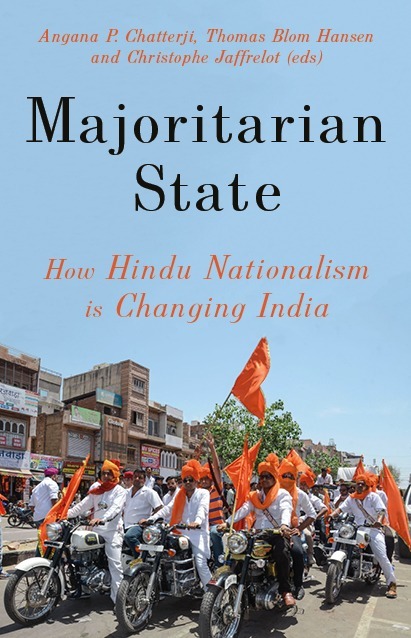
This article is a preview from the Autumn 2019 edition of New Humanist
Majoritarian State: How Hindu Nationalism Is Changing India (Hurst) by Angana P. Chatterji, Thomas Blom Hansen and Christophe Jaffrelot (eds.)
This collection of 21 essays was published on the eve of the 2019 elections in India, before the authors would have known that the Bharatiya Janata Party (BJP), the Hindu nationalist party led by Narendra Modi, would sweep back into power with an increased majority. Reading it in the light of that landslide victory, I realise that the trends mapped in this book on the BJP’s careful construction of a hegemonic state, with its tentacles reaching into all political, social and cultural institutions, are spot-on.
Collectively, the essays paint a picture of a democratic state with a progressive constitution which embodies the ideals of secularism, but sees non-state actors advancing Hindutva, a political ideology based on Hindu exclusivism. These are a network of organisations affiliated to the far-right RSS (Rashtriya Swayamsevak Sangh) whose vigilantes terrorise minorities, particularly Muslims.
To date, the BJP has not tampered with the constitution. It has relied on legislation already enacted by the Indian National Congress to curb free speech. But the real threat to civil liberties is from mob violence. One of the editors, Thomas Blom Hansen, asserts that “Violence is indeed a foundational element of Hindutva – as ideology and as political action”, which contradicts the popular notion of Hinduism as a peaceful philosophy and lifestyle. While violence is useful to the BJP, at the same time, it cannot be seen to be losing control of law and order.
There has been a series of high-profile lynchings of Muslims accused of cattle smuggling or consuming beef. (Cows are sacred in Hinduism.) Couples in interfaith marriages have been harassed, especially where Hindu women have married Muslim men. Their husbands or boyfriends have been beaten up and accused of “love jihad”, apparently a Muslim strategy to forcibly convert Hindu girls to Islam. Vigilantes, with police collusion, broke up a birthday party in the southern city of Mangalore because unmarried men and women were engaging in “ugly activities”. When the Forum against Atrocities on Women protested against this incident they received a letter in badly-written English from the Sangh Parivar, the family of Hindu nationalist groups: “You will better stop all your anti-Hindu activity before you realise the taste of slap or something else which will be done in well planned manner [sic].”
As Suhas Palshikar’s essay argues, this is all in aid of the construction of a hegemonic project where “Modi and the BJP needed to combine the acceptable and controversial”. A 2017 Pew report found that more than half the population of India supported autocratic rule. This is surprising given India’s pride in its self-image as the largest democracy in the world, but perhaps explains why large sections of the Indian populace have bought into the idea that a majority, whether defined on ethnic or religious lines, has legitimacy and moral force by virtue of numbers.
Modi has announced a number of popular projects such as Clean India, Make in India, Skill India and Digital India where the emphasis is on opportunity and achievement replacing the welfare and redistribution emphasis of Congress policies under the slogan “Eradicate poverty”. Modi has delivered on none of these. His populist measures extend to replacing VIP culture with EPI where “Every Person is Important”. Like Trump and Farage, Modi emphasises his outsider status in Delhi. The failure of his promise of job creation is seen as his Achilles’ heel yet it didn’t stop him from easily winning the 2019 elections.
There are notable absences in the book. There is nothing on the role of right-wing Hindu women in the BJP and RSS cadre. Nothing on the dilemmas faced by feminists whose support for the Uniform Civil Code, a campaign to replace laws based on religion with common secular laws, is tainted by the BJP’s enthusiastic support of it as a weapon against the Muslim community. The reduced space for a secular feminist response is indirectly seen in the essay by Flavia Agnes, a feminist lawyer who argues that the sharia precepts on instant divorce give Muslim women more rights than is acknowledged by those campaigning against it. But she does not go the extra mile to recognise that religious laws can never give women their full rights.

